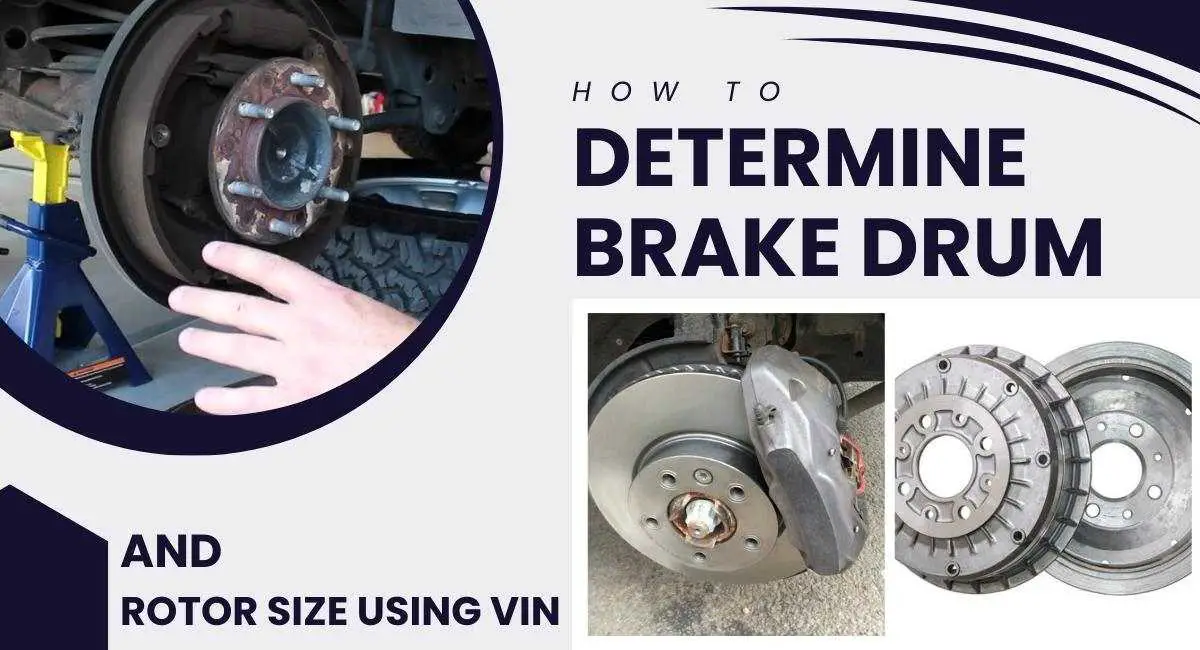Proper brake drum and rotor sizing are critical for ensuring the safety and performance of your vehicle. Having the correct brake drum and rotor size is essential for efficient braking and maintaining the overall health of your vehicle’s braking system.
To determine brake drum and rotor size using VIN, consider checking with your provider of automotive components. They should possess the capability to access this information from their database. However, vehicles occasionally come with diverse braking systems, and the only reliable method to ascertain the size is measuring its diameter.
This comprehensive guide will explore how to determine brake drum and rotor sizes using your Vehicle Identification Number (VIN) and provide a step-by-step method for measuring drum brakes when necessary.

How to Determine Brake Drum Size by VIN
While you’re about to learn to determine brake drum size by VIN, it is crucial to know what VIN is. So, here’s a simple definition of VIN—your VIN, or Vehicle Identification Number, is a unique code that identifies your vehicle and is named as stipulated in ISO3779 and ISO4030 standards. The VIN consists of a sequence of 17 characters, which include both digits and letters.
Locate the VIN
Now that you’re familiar with it, you must locate it. You can typically find the VIN in several locations, including on the dashboard near the windshield, the driver’s side door jamb, or under the hood near the engine. You may also find the VIN mentioned in your vehicle’s registration or insurance documents.
Interpret VIN Characters
Your VIN contains letters, numbers, and valuable information about your vehicle, including the brake drum size. But what do the 17 digits within your VIN represent?
- The first digit provides insight into the vehicle’s place of origin, indicating the country of manufacture.
- The second digit identifies the manufacturer behind the vehicle.
- The third digit tells the vehicle type or division.
- In digits four through eight, they unveil crucial information about the vehicle, including the brand, body style, engine size and type, model, and series.
- The ninth digit is a security code, signifying that the manufacturer has authorized the VIN.
- The tenth digit corresponds to the model year of the automobile.
- The eleventh number discloses the specific assembly plant that produced your vehicle.
- The last six digits are the distinctive vehicle production numbers, representing the vehicle’s serial number.
However, determining the brake drum size from the VIN alone can be tricky because it varies by manufacturer.
VIN Decoder Tools
You can use online VIN decoder tools to decipher the VIN and extract your brake drum size information. Many websites and apps provide free or paid services to decode your VIN and provide detailed information about your vehicle, including its brake drum size.
Manufacturer Specifics
Different vehicle manufacturers have specific VIN codes related to brake drum size. While a general VIN decoder can give you basic information, consulting the manufacturer’s documentation for precise details on interpreting the VIN for your specific make and model is essential.
How to Measure Drum Brakes
While using the VIN to determine your brake drum size is the easiest and most accurate method, there may be instances where you need to measure your drum brakes physically. Here’s how you can do that:
The tools and materials you’ll need include:
- A set of calipers (either digital or manual)
- Safety glasses
- A ruler or tape measure
- A micrometer (optional for more precise measurements)
Safety Precautions
Before you begin, ensure you securely support your vehicle on jack stands and you’ve removed the wheel and brake drum for access. Ensure the vehicle is on a level surface and the emergency brake is engaged.
Measuring Drum Brakes
To measure drum brakes, examine the brake drum for visible damage, scoring, or irregularities that may affect your measurements. It’s crucial to have a drum in good condition for accurate measurements.
Wear safety glasses to protect your eyes from debris or brake dust while working. If you’re using digital calipers, turn them on and set them to measure in millimeters or inches, depending on your preference. If you’re using manual calipers, ensure they are set to zero correctly.
Select the Measuring Points. Here, you will measure two critical dimensions of the brake drum:
- Measure the drum’s outer diameter by placing the calipers’ jaws across the broadest part of the exterior surface.
- Measure the inner diameter by placing the calipers inside the drum against the inner surface. It is where the brake shoes make contact.
Take the Measurement:
- For digital calipers, gently place the jaws of the calipers on the respective surfaces (outer and inner).
- For manual calipers, insert the jaws inside the drum for the inner diameter measurement and across the exterior surface for the outer diameter measurement. Gently tighten the calipers until they contact the surface.
- The measurement will be displayed on the screen if you’re using digital calipers. If you’re using manual calipers, read the measurement from the scale on the tool. Make sure to take note of whether it’s in millimeters or inches.
Now, double-check by measuring the diameters at several points around the outer and inner surfaces to confirm the consistency of your measurements. If there are variations, consider the smallest measurement for the inner diameter and the largest measurement for the outer diameter.
Write down or record the measurements for the outer and inner diameters. Then, consult your vehicle’s service manual or manufacturer specifications to compare the measured diameters to the recommended or acceptable ranges. It will help you determine whether the drum is within its serviceable limits.
Also, you can use a micrometer for more precise measurements, especially when dealing with close tolerances. A micrometer provides accurate measurements to a thousandth of an inch, but this is optional.
Depending on your measurements and the specifications, you can decide whether the drum requires maintenance, such as turning or replacement. Always follow proper maintenance and safety procedures when servicing your vehicle’s braking system.
Measuring drum brakes is critical to ensuring the safety and effectiveness of your vehicle’s braking system. If you have any doubts about your measurements or need to perform brake maintenance, it’s advisable to consult a qualified mechanic for professional assistance.
How to Check Rotor Size by VIN Number
Like checking brake drum size, you can use your VIN to determine the correct rotor size for your vehicle. Still, you can consult your vehicle’s manufacturer or use online VIN decoder tools to extract this information. Here’s how you can check rotor size using the VIN:
- You must first locate your VIN. Carefully copy down the 17-character VIN from where you found it. Make sure there are no errors in the characters, as even a single mistake can lead to incorrect information.
- Then, use an Online VIN Decoder. Online VIN decoder tools are an efficient way to retrieve information about your vehicle’s rotor size. Simply input your VIN; these tools will provide information, including the rotor specifications. Search for an online VIN decoder or lookup tool. Many websites offer free VIN decoding services.
- Enter the complete VIN into the designated field on the VIN decoding website. Be sure to double-check the accuracy of the VIN.
- Initiate the decoding process. The tool will retrieve and display detailed information about your vehicle based on the VIN, including the rotor size.
- Review the Results. The online VIN decoder will provide a breakdown of your vehicle’s specifications. Pay attention to the section about the braking system or rotor size. It may list rotor dimensions, type, or other relevant information.
- For additional verification, you can consult the official documentation from your vehicle’s manufacturer. The manufacturer’s website or customer support service may provide specific details about your vehicle’s rotor size based on the VIN.
- If you need clarification on the rotor size and want to double-check, consider visiting a dealership or a trusted mechanic. They can inspect your vehicle and confirm the rotor size. It is handy if you have concerns about the accuracy of the online VIN decoder’s information.
As with brake drum size, manufacturers may encode rotor size differently within the VIN. Therefore, it’s advisable to consult your manufacturer’s documentation for precise rotor size details, especially if you’re working on a specialty vehicle or one from a manufacturer with unique coding practices.
Safety and Performance Considerations
Safety and performance considerations are paramount when determining brake drum and rotor size using the Vehicle Identification Number (VIN). Accurate sizing of these components is crucial to ensure the safe and efficient operation of your vehicle’s braking system. Here are some essential safety and performance considerations to keep in mind!
Braking Performance: The correct brake drum and rotor size is vital for optimal braking performance. An improper size can lead to decreased braking efficiency, longer stopping distances, and compromised safety on the road.
Heat Dissipation: The size of the brake drum and rotor affects the heat dissipation capability of the braking system. If the components are too small, they may not effectively dissipate heat generated during braking, potentially leading to brake fade and reduced performance.
Compatibility: Properly sized brake components ensure compatibility with other brake system parts, including brake pads and calipers. Mismatched components can lead to uneven wear and decreased effectiveness.
Weight Distribution: The size of the brake components can impact the vehicle’s weight distribution. A well-balanced weight distribution ensures stability and control, particularly during braking. More than appropriately sized components can disrupt this balance.
Safety in Emergency Situations: In emergency braking situations, the correct brake drum and rotor size are crucial for the vehicle’s ability to reach a quick and controlled stop. The wrong size can result in reduced responsiveness when you need it most.
Reducing Brake Fade: Brake fade occurs when excessive heat buildup causes a decrease in braking efficiency. Properly sized components are designed to manage heat effectively, reducing the risk of brake fades during heavy or prolonged braking.
Overall Vehicle Handling: Brake components play a significant role in the overall handling and stability of the vehicle. The right size ensures the vehicle handles predictably and safely during different driving conditions.
Towing and Load Capacity: If your vehicle’s design is for towing or carrying heavy loads, the correct brake drum and rotor size is essential for maintaining safe towing and load-carrying capabilities. Inadequate brake components can compromise your ability to control the vehicle’s stopping power.
Important Read: Understanding Why Fog Lights Turn Off with High Beams
Using the wrong-sized brake drums or rotors can lead to decreased braking performance, overheating, and even potential accidents. It’s crucial to prioritize safety by verifying and using the correct sizes.
Conclusion
Ensuring your vehicle has the correct brake drum and rotor sizes is fundamental to vehicle maintenance and safety. While using the VIN to determine these sizes is a convenient method, having the knowledge and tools to measure them physically can be invaluable in certain situations. Always prioritize safety and accuracy when working on your vehicle’s braking system, and consult your manufacturer’s documentation for any specific coding practices related to brake drum and rotor size in the VIN.
